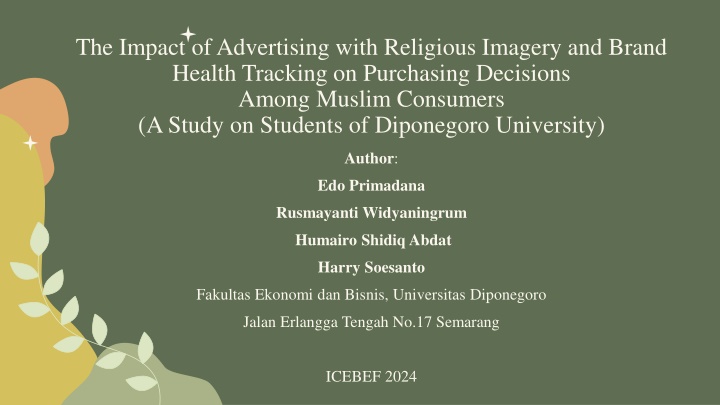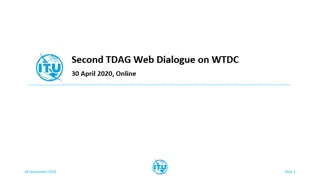
Impact of Religious Imagery in Advertising on Muslim Consumers' Purchasing Decisions
This study explores the influence of religious imagery in advertising and brand health tracking on purchasing decisions among Muslim consumers, focusing on students at Diponegoro University. It aims to investigate the role of religious imagery, understand the impact of brand health tracking, and explore the mediating role of buying interest. The research emphasizes the cultural and religious relevance in advertising strategies for diverse markets, particularly in Indonesia, where tailored approaches are essential. Through a literature review, the study delves into the significance of religious advertising, brand health, buying interest, and purchasing decisions in consumer behavior.
Download Presentation

Please find below an Image/Link to download the presentation.
The content on the website is provided AS IS for your information and personal use only. It may not be sold, licensed, or shared on other websites without obtaining consent from the author. If you encounter any issues during the download, it is possible that the publisher has removed the file from their server.
You are allowed to download the files provided on this website for personal or commercial use, subject to the condition that they are used lawfully. All files are the property of their respective owners.
The content on the website is provided AS IS for your information and personal use only. It may not be sold, licensed, or shared on other websites without obtaining consent from the author.
E N D
Presentation Transcript
The Impact of Advertising with Religious Imagery and Brand Health Tracking on Purchasing Decisions Among Muslim Consumers (A Study on Students of Diponegoro University) Author: Edo Primadana Rusmayanti Widyaningrum Humairo Shidiq Abdat Harry Soesanto Fakultas Ekonomi dan Bisnis, Universitas Diponegoro Jalan Erlangga Tengah No.17 Semarang ICEBEF 2024
Research Background Research Background Student Consumer Focus This research emphasizes student consumers at Diponegoro University Semarang, a unique demographic. Cultural & Religious Relevance Understanding cultural and religious contexts is crucial for effective advertising in diverse markets. Increasing Competition The personal care market faces growing competition, necessitating innovative advertising strategies. Inconsistency Research Focusing on Muslim consumers in Indonesia highlights the need for tailored marketing approaches. Health Brand Tracking The role of brand health is considered important in marketing. To maintain product relevance. Based on the need to understand more deeply advertising that utilizes religious and brand health tracking to influence purchasing decisions
Research Objectives Investigate the role of religious imagery in advertisements on consumer buying interest and purchase decision Understand the impact of brand health tracking on purchasing decisions Explore the mediating role of buying interest
Literature Review Religious Advertising: The use of symbols, values, and themes from a specific religion to create an emotional connection with the target audience. Builds loyalty and emotional appeal (Alserhan, 2019) Brand Health: The overall well-being of a brand in terms of how it is perceived by consumers. This includes brand awareness, reputation, trust, and loyalty. Impacts trust, awareness, and consumer retention (Keller, 2020) Buying Interest: Consumer s willingness to purchase a product after being exposed to advertising or gaining awareness of the brand. Strong predictor of purchase decisions (Rajan, 2020)
Literature Review Buying Interest: Consumer s willingness to purchase a product after being exposed to advertising or gaining awareness of the brand. Strong predictor of purchase decisions (Rajan, 2020) Purchasing Decision: The consumer's process of selecting a product or service after going through stages of problem recognition, information search, evaluation of alternatives, and final choice. Kotler & Keller (2016)
Research Model Research framework showing relationships between:
Hypotheses Based on the background of the research problem and the theoretical framework of the research, the hypothesis formulated in this study is as follows: H1: Ads with religious imagery have a positive effect on buying interest. H2: Brand health tracking has a positive effect on buying interest. H3: Buying interest has a positive effect on purchase decisions. H4: Ads with religious imagery have a positive effect on purchase decisions with buying interest as an intervening variable. H5: Brand health tracking has a positive effect on purchasing decisions with buying interest as an intervening variable.
Methodology Quantitative Explanatory Approach This study adopts a quantitative explanatory research design to analyze the effects of advertising. Target Population The survey involved 150 female students from Diponegoro University, focusing on their consumer behavior. Data Collection Method Purposive sampling, survey using Likert scales Analysis Techniques Analysis was performed using multiple linear regression and Structural Equation Modeling (SEM) via AMOS software.
Results Test Result Interpreted The critical ratio value was obtained in the range of 2.58 All observed variables were normally distributed in multivariate or univariate. Data Normality Test The highest value of mahalanobis was 27,280 which was smaller than 34,528 That there were no cases of multivariate outliers. Test Outliers The determinant of sample covariance matrix was 0.014 No data is found that is singular. So that the data in this study is worthy of use. Multicollinearity and Singularity Tests Construct reliability are above the significance level, which is >0.70. And the average variance extracted value produced is above the significance level, which is >0.50. Each indicator used in this study is reliable. Reliability and Variance Extract Test
Results Goodness of Fit Model Criteria Model Evaluation Baik Goodness of Fit Indeks Cut-off Value Result Carmines & Melver (1981) Df=48 = 129.69 0.05 0.08 1.20 0.90 0.90 0.95 0.95 57.171 Chi - Square 0.176 0.041 1.191 0.899 0.870 0.980 0.974 Baik Baik Baik Marginal Marginal Baik Baik Probability RMSEA Chi square / df GFI AGFI TLI CFI The chi-square value obtained was 57.171 with a significance of 0.176, indicating that the model used was well accepted. the feasibility test of the SEM model has met the acceptance requirements where the constructs used to form a research model have met the feasibility criteria of a model.
Results Regression Weights Estimate 0.609 0.949 0.533 1.055 0.023 S.E. 0.212 0.300 0.236 0.282 0.355 C.R. 1.560 3.158 2.258 3.746 0.132 P 0.004 0.002 0.024 BI <--- ARI BI <--- BHT PD <--- BI PD <--- ARI PD <--- BHT *** 0.048
Results H1: Ads with religious imagery have a positive effect on buying interest. H2: Brand health tracking has a positive effect on buying interest. H3: Buying interest has a positive effect on purchase decisions. H4: Ads with religious imagery have a positive effect on purchase decisions with buying interest as an intervening variable. H5: Brand health tracking has a positive effect on purchasing decisions with buying interest as an intervening variable. o o o o o
Conclusion Religious and health-based marketing strategies are effective role in shaping buying interest, which will ultimately affect the purchase decision of Sunsilk Hijab Refresh products among students of Diponegoro University Semarang. Buying interest is a crucial mediating factor. Future studies should expand to different demographics.
Q&A Thankyou Any question?





















